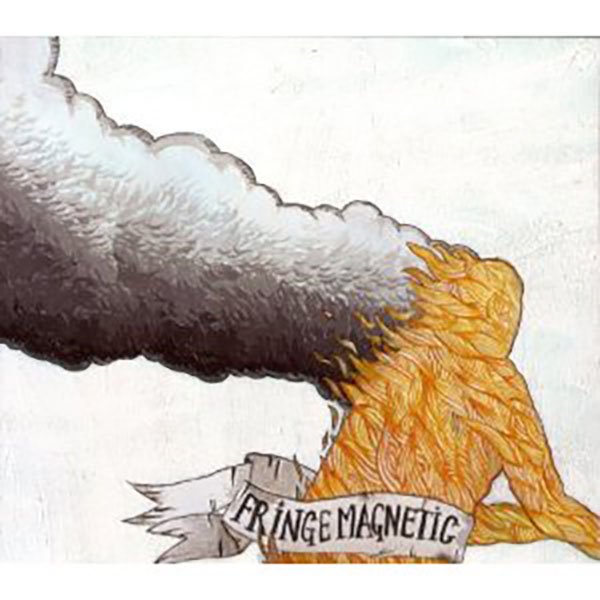
by Ian Mann
March 07, 2011
/ ALBUM
Fringe Magnetic have quickly developed into a unique new presence on the British music scene.
Fringe Magnetic
“Twistic”
(Loop Records LOOP1012)
Fringe Magnetic’s début release “Empty Spaces” was one of the surprise successes of 2010 and the group’s live appearance at Cheltenham Jazz Festival was a definite festival highlight. Led by trumpeter and composer Rory Simmons the group incorporates many of the leading lights of North London’s increasingly influential Loop Collective, many of them band-leaders in their own right.
“Empty Spaces” was a curious mix of jazz, folk and classical influences mixing instrumentals with highly stylised vocal set pieces featuring the very different voices of Elisabeth Nygaard and Andrew Plummer. “Twistic” refines the previous album’s approach with a similarly eclectic mix of songs and instrumentals. Nygaard and Plummer are again central to the proceedings and there is also a cameo appearance from Jamie Cullum, Simmons’ regular employer-the trumpeter is a fixture in Cullum’s touring band.
“Empty Spaces” was the work of a nine piece group but although the overall cast list is larger this time round the core group has been reduced in size. As a result we get to hear rather more of Simmons himself which is no bad thing. Besides the leader on trumpet and flugelhorn the mainstays remain Tori Freestone (flute), James Allsopp (clarinet and bass clarinet), Kit Massey (violin), Natalie Rozario (cello) and Ben Reynolds (drums/percussion). Pianist Ivo Neame, bassist Jasper Hoiby and clarinettist Robin Fincker, regulars last time round, are now confined to occasional guest contributions. The cast list is completed by Norwegian sound artist Terje Evensen who adds his electronic fairy dust to the song “Apocryphal”.
The album commences with the instrumental title track, a delightfully rich and whimsical blend of brass, reeds, strings and percussion with Simmons’ bright trumpeting at it’s heart. The purity of Simmons’ tone contrasts well with the grainy lower register sounds of cello and bass clarinet. As on the previous record Reynold’s imaginative and colourful drum and percussion work is a delight throughout the album.
It’s Fringe Magnetic’s policy for the singers to contribute their own lyrics. Nygaard’s “Awake Like This” evokes the misery of insomnia, her voice pure and clear yet simultaneously bruised and vulnerable. A typically imaginative arrangement featuring flute and cello plus Simmons’ melancholy trumpet is the perfect foil for the fragile beauty of the singer’s performance.
The opening of “10th Witness” features brief squiggles of free improvisation set around a quirky central theme. Occasionally drummer Reynolds hints at something approaching a hip hop groove and in the second half of the tune Natalie Rozario lays down a naggingly insistent cello pattern that recalls the minimalism of Steve Reich. Taken as a whole the piece is a surreal dreamscape where elements of chamber jazz , free improv and other musics meet.
Andrew Plummer’s deranged shanty “Fire In The Galley” was one of the most remarkable moments of that 2010 Cheltenham performance. Here he commits his Tom Waits/Captain Beefheart growl to disc, particularly appropriate, perhaps, in the wake of the good Captain’s recent demise. As I’ve said before, a whole album from Plummer in his World Sanguine Report incarnation is rather too much to take, but here his trademark bohemian abrasiveness adds a welcome touch of roughness at just the right time.
“Biramous” almost begins as chamber music, a charming piece featuring strings, flute, trumpet and glockenspiel. Later the piece evolves into a melancholic, vaguely whimsical march, the rich blend of instruments underpinned by Reynold’s military snare.“Near Morningside” is a close relation, the delightfully quirky but nevertheless highly disciplined arrangement allowing plenty of space to string players Massey and Rozario.
“Apocryphal” features the voice and lyrics of Nygaard plus the ethereal space effects of sound artist Evensen. The Norwegian adds his trademark electronica to a slowed down, melancholic Fringe Magnetic arrangement featuring cello, trumpet and bass clarinet. Nygaard only comes in towards the end of the song adding a vaguely anthemic element to a piece that’s largely concerned with atmospherics and the treatment of sound. Interesting, and thanks to Evensen, intrinsically Nordic in feel.
“Wait Drags On” places the emphasis more firmly on Nygaard’s singing and lyrics. Her voice is distinctive, drawing on not only the classic jazz vocal lineage but also on more contemporary figures like Kate Bush, Bjork and Joanna Newsome. The piece also features a brilliant extended flugel horn solo from Simmons, one of the few occasions where he really allows himself to cut loose. He’s excellent throughout but as a soloist this is his stand out moment of the album.
“A Simple Matter” contrasts Nygaard’s sensual whisper with Plummer’s stentorian growl. At times it’s reminiscent of Kate Westbrook’s vocal duets with Phil Minton in the various incarnations of Mike Westbrook’s bands. The music of Bertolt Brecht and Kurt Weill is another obvious reference point.
The courtly instrumental “Tertulanio” acts as a gentle palette cleanser before the closing “Play It Once More” , a vocal duet between Nygaard and Jamie Cullum. I’m not a fan of Cullum in his usual populist mode but here, removed from his comfort zone he’s highly effective. The piece also includes guest appearances from Neame, Hoiby and Robin Fincker-I’m assuming it’s Fincker who is responsible for the rather splendid clarinet solo.
“Twistic” is a worthy follow up to the earlier “Empty Spaces”. Like it’s predecessor it covers an impressive stylistic range with Simmons clearly determined to make each track different and something of a musical adventure. It’s highly original music and although unorthodox, eclectic, and in many ways challenging, it’s a sound that has won the group considerable critical acclaim and a loyal following. Fringe Magnetic draws on jazz, folk and classical music plus elements of musical theatre, and now electronica, to create something that’s very distinctive. Fringe Magnetic have quickly developed into a unique new presence on the British music scene.